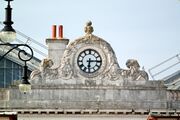Brighton Station Goods Yard
| Brighton Station |
|---|
Brighton Station Goods Yard |
|
Station | History | CabRoad | GoodsTunnel | LocoWorks | Greenway | ToyMuseum |
Brighton Station Goods Yard used to occupy the land to the East of the station, at a lower level then the passenger platforms.
Rail access to the goods yard from the West was originally provided by the steeply inclined Goods Tunnel which ducked under the passenger lines and emerged in what is now Trafalgar Arches. The yard was only separated from Trafalgar Street by a wall. The land for the goods yard and Brighton Locomotive Works has since been cleared and redeveloped and is now occupied by Trafalgar Place and by a part of the New England redevelopment.
1926 description:
Bearing in mind that special and excursion trains are dealt with at Brighton during the summer months (and frequently at other periods of the year) in very large numbers, it is often necessary to utilise portions of the goods yard for stabling trains. The goods sidings are also used on occasions for handling special traffic, this applying particularly to Lovers' Walk Yard, which is often used for the loading and unloading of troop trains and racehorse traffic during race weeks.
Although little has been said about the goods traffic at Brighton, the operating part of which also comes under the supervision of the Brighton station master, it may be mentioned that the main yard includes 11 tracks and has a capacity for 412 wagons; the north section sidings, with 5 tracks, can deal with 211 wagons, while the Lovers Walk section (4 lines and dock) can handle 106 wagons. The number of wagons dealt with in an average week at one or other of these sidings is approximately 4,500, about equally divided between arriving, despatched and transferred. Ordinarily, there are 18 arriving goods trains and 14 departing. Most of the marshalling work is done in what is known as the top yard. The North section sidings are used mainly for berthing trains and wagons, in order to keep the marshalling yard clear, though in summer some of its capacity is frequently required for stabling passenger trains.
— , J.F. Cairns, , Notable Railway Stations and their Traffic: BRIGHTON (CENTRAL), SOUTHERN RAILWAY, , The Railway Magazine, , July 1926



